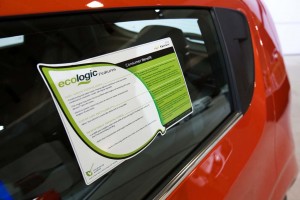
Chevy's new EcoLogic label will first appear on the new Chevrolet Sonic small car then expand to the rest of the brand's line-up.
You’ve got to go green to earn some green, it seems.
Automakers are putting ever more emphasis on their environmental efforts, touting even the most subtle efforts to win over ever more Earth-conscious buyers. That includes everything from adding new zero-emission products to their line-ups to the use of plant fibers to replace parts and components traditionally made from oil-based materials.
Manufacturers have come to realize that while it’s hard to get a premium for going green they can tarnish their image and lose sales if they don’t
Chevrolet will make sure that consumers don’t miss its efforts, starting with the compact Sonic model. It will next month introduce the maker’s EcoLogic label, designed to explain how the vehicle was made, how it can be recycled and how much fuel was saved using alternate materials. General Motors’ largest division plans to roll the EcoLogic label out across its line-up in the coming year.
“Putting our EcoLogic label on each Chevrolet is just one more way for us to share our environmental progress,” said Mark Reuss, President of General Motors North America.
Manufacturers are anxious to make sure that consumers know about the steps they are taking. While fuel economy is currently the top factor in the typical motorist’s search for a new vehicle, according to researchers like J.D. Power and Associates, industry data indicate that buyers are paying more and more attention to broad environmental issues in forming their opinions about a brand.
So, Reuss made a point of noting that GM has also converted 81 of its manufacturing plants to recycle waste, sending nothing to landfills.
Cross-town competitor Ford likes to note it was a pioneer in the “green space,” at least on the manufacturing side, when it rebuilt its vast Rouge Assembly Plant complex in the Detroit suburbs a decade ago. It was the first major automotive facility to adopt a “living roof,” with a variety of plants used to both absorb rainwater and minimize temperature shifts during cold Michigan winters and broiling summers.
Last month, Ford announced it would begin using a new material derived from a tropical plant called kenaf to substitute for traditional, oil-based materials used in car doors. It will first appear on an all-new version of the Ford Escape scheduled to reach showrooms in the coming months.
The plant, related to cotton, should offset the use of as much as 300,000 pounds of oil-based resins annually in North America and will show up in the Escape Ford is building in other parts of the world, as well.
“Kenaf and the other renewable materials in the Escape have made the vehicle more environmentally friendly and fuel efficient,” said Laura Sinclair, materials engineer for Escape.
Ford, meanwhile, is one of several automakers who have adopted the use of recycled rubber products for things like pedals and small panels. Until recently, used tires could only be dumped in landfills, creating serious environmental problems – providing breeding grounds for mosquitos, for one thing, and more than occasionally catching fire, spewing out noxious smoke. New methods can grind used rubber up for alternate applications, such as fill material for asphalt roads, or bake it to create a resin that can be recycled into a variety of materials.
Some critics question whether such efforts will really matter considering the bigger environmental impact of the automobile.
Automotive journalist Eric Evarts downplayed the Chevy EcoLogic label in a new issue of Consumer Reports, dubbing it “more self-serving and less useful than it could be.”
But proponents insist every step helps. And makers like Nissan and the Detroit Big Three won praise from environmentalists and the aggressive California Air Resources Board for lending their support to newly approved CARB rules that could put millions more zero-emission vehicles on the road by 2025.
That’s a significant turnaround in an industry where many makers – Detroit’s Big Three in particular – were long criticized for dragging their feet on new emissions and fuel economy regulations. But things began to change with the Baby Boomers and every new generation has shown an even stronger interest in environmentally friendly automobiles. The challenge is getting those shoppers to cover the cost.
A full decade ago, former Ford Motor Co. CEO Jacques Nasser warned that, “Consumers won’t pay for you to go green but they’ll penalize you if you don’t.”
Price is proving a critical obstacle to the introduction of some of the most advanced new technologies. The 2012 “Avoiders” survey, by J.D. Power and Associates, found that the $40,000 price tag – after a $7,500 federal tax credit – was the key turn-off for potential buyers of the Chevrolet Voit, for example.
Toyota is hoping to draw still more buyers into the hybrid segment with the latest member of its growing Prius “family,” the Prius C starting at around $19,000 – or roughly the same as the original liftback version of the Prius went for when it debuted in 2012.
Toyota has parlayed the familiar Prius into a strong image for environmental leadership – reflected in a new study from Consumer Reports that found it rated by American motorists as the greenest auto brand and one of the top-ranked brands overall.
But makers like GM, Ford and Honda aren’t willing to cede that lead without a fight, and they’re hoping that by delivering not only cleaner products but cleaner assembly plants that they, too, will win over increasingly green-minded motorists.
